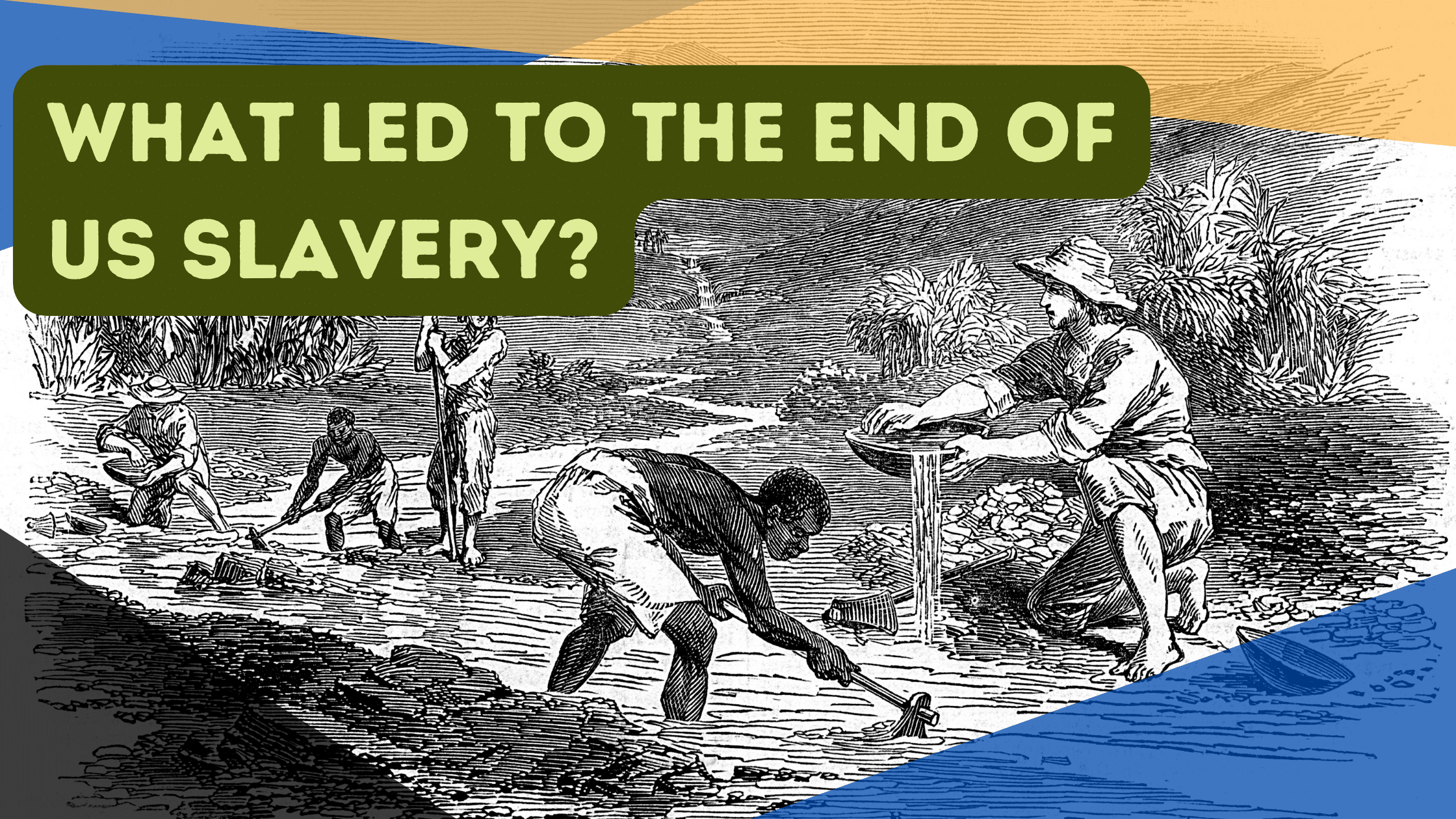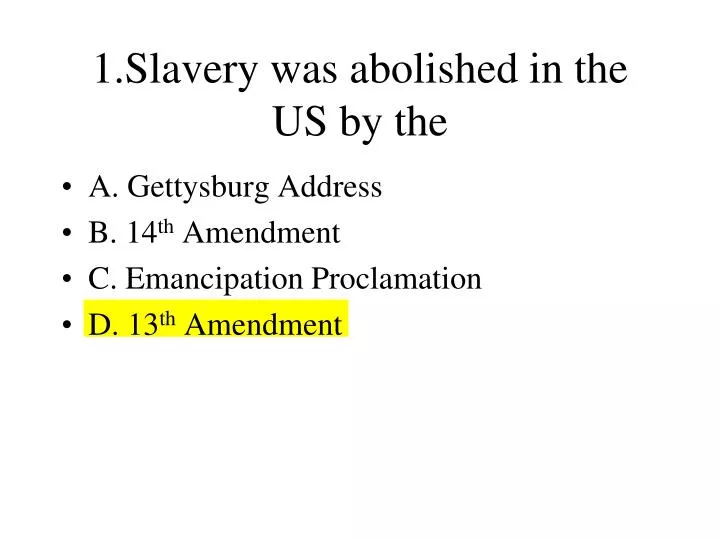When Was Slavery Abolished In The USA: A Comprehensive Historical Analysis
Slavery in the United States is one of the most significant and troubling chapters in the nation's history. The question of when slavery was abolished in the USA remains a critical topic for understanding the country's past and its ongoing quest for equality and justice. This article delves into the timeline, events, and key figures that led to the end of slavery, offering a thorough examination of this pivotal moment in American history.
The abolition of slavery in the USA did not happen overnight but was the result of decades of struggle, advocacy, and conflict. Understanding the timeline and the factors that contributed to this monumental change provides insight into the complexities of the nation's development. This article explores the legal, social, and political aspects of slavery's abolition, ensuring a well-rounded view of this transformative period.
By examining historical records, legislative acts, and the contributions of abolitionists, we aim to provide a detailed account of the events leading up to the abolition of slavery. This article is designed to be informative and accessible, making it an essential resource for anyone seeking to deepen their understanding of this crucial moment in American history.
Read also:Catalin Drula The Rising Star Shaping The Future Of Technology
Table of Contents:
- Timeline of Slavery Abolition in the USA
- The Emancipation Proclamation
- The 13th Amendment: A Legal Milestone
- The Abolitionist Movement: Key Figures and Contributions
- The Civil War and Its Impact on Slavery
- Reconstruction Era: Challenges and Progress
- Long-term Effects of Slavery Abolition
- Common Myths About Slavery Abolition
- Statistical Insights into Slavery in the USA
- Conclusion and Call to Action
Timeline of Slavery Abolition in the USA
Slavery in the United States officially ended with the ratification of the 13th Amendment in 1865. However, the journey toward abolition began much earlier, marked by significant events and legislative actions. Below is a detailed timeline:
- 1776: The Declaration of Independence is adopted, emphasizing the principle of liberty, yet slavery persists.
- 1787: The Northwest Ordinance bans slavery in the Northwest Territory, setting a precedent for future territories.
- 1808: The United States bans the importation of enslaved Africans, though domestic slavery continues.
- 1863: President Abraham Lincoln issues the Emancipation Proclamation, declaring enslaved people in Confederate states to be free.
- 1865: The 13th Amendment is ratified, officially abolishing slavery throughout the United States.
This timeline highlights the gradual progression toward the abolition of slavery, underscoring the complexity of the issue and the efforts required to achieve lasting change.
The Emancipation Proclamation
Understanding the Proclamation
The Emancipation Proclamation, issued by President Abraham Lincoln on January 1, 1863, was a pivotal moment in the fight against slavery. While it did not immediately free all enslaved people, it declared that those held in Confederate states "shall be then, thenceforward, and forever free." This executive order changed the character of the Civil War, making the abolition of slavery a central goal.
Impact and Limitations
Although the Emancipation Proclamation was a significant step, its reach was limited. It only applied to Confederate states in rebellion and did not affect border states or areas under Union control. However, it paved the way for the eventual abolition of slavery across the nation.
The 13th Amendment: A Legal Milestone
The 13th Amendment to the United States Constitution, ratified on December 6, 1865, officially abolished slavery and involuntary servitude, except as punishment for a crime. This amendment was a culmination of the efforts of abolitionists and lawmakers who sought to eliminate the institution of slavery once and for all.
Read also:Brett Heggie The Rising Star In The World Of Sports And Entertainment
Data from historical records show that the ratification process involved significant political maneuvering and widespread support from various factions within the government. The amendment's passage marked a turning point in American history, symbolizing the nation's commitment to equality and justice.
The Abolitionist Movement: Key Figures and Contributions
Who Were the Abolitionists?
The abolitionist movement was a social and political campaign to end slavery in the United States. Key figures such as Frederick Douglass, Harriet Tubman, and William Lloyd Garrison played crucial roles in advocating for the end of slavery. Their efforts included publishing anti-slavery literature, organizing protests, and providing assistance to escaped enslaved individuals through the Underground Railroad.
Contributions of Abolitionists
- Fredrick Douglass: A former enslaved person turned influential orator and writer, Douglass's speeches and writings exposed the horrors of slavery.
- Harriet Tubman: Known for her work with the Underground Railroad, Tubman helped hundreds of enslaved people escape to freedom.
- William Lloyd Garrison: Founder of the abolitionist newspaper The Liberator, Garrison was a vocal advocate for immediate emancipation.
Their collective efforts helped to shift public opinion and build momentum for the abolition of slavery.
The Civil War and Its Impact on Slavery
The Civil War (1861–1865) was a defining conflict that directly addressed the issue of slavery. The war was fought primarily over the question of whether states had the right to secede and maintain the institution of slavery. The Union's victory, led by President Lincoln, resulted in the abolition of slavery and the preservation of the United States as a unified nation.
According to historical sources, the war claimed the lives of approximately 620,000 soldiers, making it one of the deadliest conflicts in American history. The sacrifices made during this period underscored the importance of ending slavery and achieving a more just society.
Reconstruction Era: Challenges and Progress
What Was Reconstruction?
The Reconstruction Era (1865–1877) was a period of rebuilding and reintegration following the Civil War. During this time, the federal government worked to integrate formerly enslaved people into society, granting them citizenship and voting rights through the 14th and 15th Amendments.
Challenges Faced
Despite these advancements, the Reconstruction Era faced significant challenges, including resistance from former Confederate states and the rise of organizations like the Ku Klux Klan. These obstacles slowed progress and highlighted the ongoing struggle for racial equality in the United States.
Long-term Effects of Slavery Abolition
The abolition of slavery had profound and lasting effects on American society. It laid the foundation for the civil rights movement and inspired future generations to continue fighting for equality and justice. However, the legacy of slavery continues to influence social and economic conditions in the United States today.
Statistical data from the U.S. Census Bureau indicates that African Americans still face disparities in areas such as education, employment, and healthcare, underscoring the need for continued efforts to address systemic inequalities.
Common Myths About Slavery Abolition
There are several misconceptions surrounding the abolition of slavery in the USA. For example:
- Myth: The Emancipation Proclamation freed all enslaved people immediately.
- Reality: It only applied to Confederate states and did not affect border states or areas under Union control.
- Myth: Slavery ended peacefully and without conflict.
- Reality: The abolition of slavery was the result of a bloody civil war and significant political and social upheaval.
Addressing these myths helps to provide a more accurate understanding of the historical context surrounding slavery's abolition.
Statistical Insights into Slavery in the USA
Data from historical records reveal the extent of slavery in the United States:
- By 1860, there were approximately 4 million enslaved people in the United States.
- Slavery was concentrated in the Southern states, where it played a central role in the economy.
- The economic value of enslaved labor was estimated to be worth billions of dollars, making it a significant part of the national economy.
These statistics highlight the scale of the issue and the challenges faced in achieving abolition.
Conclusion and Call to Action
In conclusion, the abolition of slavery in the USA was a monumental achievement that required the efforts of countless individuals and organizations. From the Emancipation Proclamation to the ratification of the 13th Amendment, this period marked a turning point in American history. However, the legacy of slavery continues to influence society today, underscoring the importance of ongoing efforts to address systemic inequalities.
We invite you to engage with this topic by leaving a comment, sharing this article, or exploring other resources related to American history. By continuing to learn and discuss these issues, we can work toward a more just and equitable future for all.


